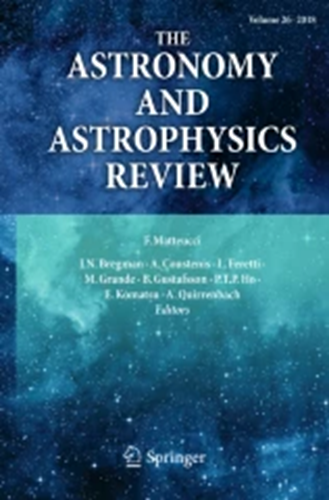Star formation histories of Coma cluster galaxies matched to simulated orbits hint at quenching around first pericenter
IF 26.5
1区 物理与天体物理
Q1 ASTRONOMY & ASTROPHYSICS
引用次数: 4
Abstract
We study the relation between star formation history of galaxies falling into a high-density cluster environment and their likely orbital histories using both observational and simulation data. We use high-resolution spectra of 12 galaxies of the Coma Cluster around NGC 4874 (the X-ray center of the Coma Cluster). The stellar and kinematic properties of the galaxies are modeled using STECKMAP. We extract the probability distribution of two orbital parameters - infall and pericenter times - of these galaxies from N-body dark matter only simulations extending up to z = -1/2 ( ~10 Gyr in the future). The probability distribution of orbital parameters is compensated for the interloper probabilities of the satellites. We carry out a probability-based study to compare the cumulative (probability) distribution of the two orbital parameters with the star formation rates and the fraction of stellar mass formed. We find that massive galaxies (M_* > 10^10 M_sun) are quenched even before falling into the cluster environment. This may be due to internal quenching mechanisms or group pre-processing, although it is hard to ascertain the individual contribution of various processes. Lower mass galaxies form stars between infall and first pericenter passage and all the galaxies in our sample are quenched by the time of their first pericentric passage. Ram pressure and tidal stripping are likely to be the dominant processes as they peak with proximity to the cluster center.后发星团星系的恒星形成历史与模拟轨道相匹配,暗示在第一中心周围淬火
我们利用观测和模拟数据研究了高密度星团环境中星系的恒星形成历史与它们可能的轨道历史之间的关系。我们使用了NGC 4874(后发星团的x射线中心)周围的12个后发星团的高分辨率光谱。星系的恒星和运动特性用STECKMAP建模。我们从n体暗物质模拟中提取了这些星系的两个轨道参数-落球和周心时间的概率分布,扩展到z = -1/2(未来约10 Gyr)。轨道参数的概率分布对卫星的干扰概率进行了补偿。我们进行了一项基于概率的研究,以比较两个轨道参数的累积(概率)分布与恒星形成速率和恒星质量形成的比例。我们发现大质量星系(M_* > 10^10 M_sun)甚至在落入星团环境之前就被淬灭了。这可能是由于内部淬火机制或群体预处理,尽管很难确定不同工艺的个人贡献。质量较低的星系在落入和第一次周心通道之间形成恒星,我们样本中所有的星系都在它们第一次周心通道时被淬灭。Ram压力和潮汐剥落可能是主要的过程,因为它们在靠近星团中心的地方达到峰值。
本文章由计算机程序翻译,如有差异,请以英文原文为准。
求助全文
约1分钟内获得全文
求助全文
来源期刊

The Astronomy and Astrophysics Review
地学天文-天文与天体物理
CiteScore
45.00
自引率
0.80%
发文量
7
期刊介绍:
The Astronomy and Astrophysics Review is a journal that covers all areas of astronomy and astrophysics. It includes subjects related to other fields such as laboratory or particle physics, cosmic ray physics, studies in the solar system, astrobiology, instrumentation, and computational and statistical methods with specific astronomical applications. The frequency of review articles depends on the level of activity in different areas. The journal focuses on publishing review articles that are scientifically rigorous and easily comprehensible. These articles serve as a valuable resource for scientists, students, researchers, and lecturers who want to explore new or unfamiliar fields. The journal is abstracted and indexed in various databases including the Astrophysics Data System (ADS), BFI List, CNKI, CNPIEC, Current Contents/Physical, Chemical and Earth Sciences, Dimensions, EBSCO Academic Search, EI Compendex, Japanese Science and Technology, and more.
 求助内容:
求助内容: 应助结果提醒方式:
应助结果提醒方式:


